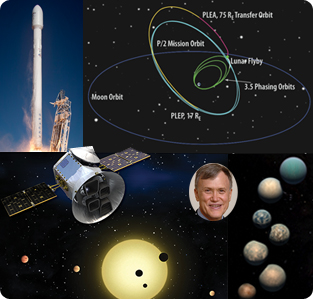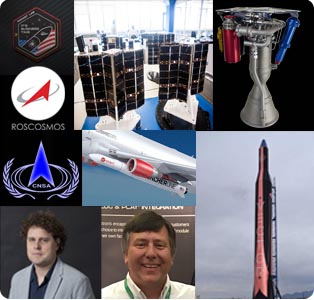TESS to Launch April 16 in Search of New Worlds
|
MONDAY Ongoing…
|

![]() = All times
= All times
for terrestrial events in local time unless noted.
![]() = All times for international terrestrial events in local time unless noted.
= All times for international terrestrial events in local time unless noted.
![]() = All times for space events, and…
= All times for space events, and…
![]() = All times for international space / astro events in Hawaii Standard Time unless noted. Add 10 hours to obtain UT (‘Universal Time’).
= All times for international space / astro events in Hawaii Standard Time unless noted. Add 10 hours to obtain UT (‘Universal Time’).
Weekly Planet Watch – Evening Planets: Venus (W), Jupiter (S); Morning Planets: Mars (SE), Saturn (SE).
Three Mid-April Launches and Commercial Spaceflight Updates
|
Continued from…
TUESDAY
|
![]() Apr 17 — Moon: 5.2° SSE of Venus, 12:00.
Apr 17 — Moon: 5.2° SSE of Venus, 12:00.
![]() Apr 17 — Amor Asteroid 2018 GC2: Near-Earth Flyby (0.023 AU)
Apr 17 — Amor Asteroid 2018 GC2: Near-Earth Flyby (0.023 AU)
WEDNESDAY
![]() Apr 18 — ISPCS, Colorado Springs CO: International Symposium for Personal and Commercial Spaceflight Meet Up at 34th Space Symposium; Broadmoor Hotel South Tower Room 3316, 17:30-18:30.
Apr 18 — ISPCS, Colorado Springs CO: International Symposium for Personal and Commercial Spaceflight Meet Up at 34th Space Symposium; Broadmoor Hotel South Tower Room 3316, 17:30-18:30.
![]() Apr 18 — Foothill College, Los Altos Hills CA: Silicon Valley Astronomy Lecture Series: Rubble Piles in the Sky: The Science, Exploration, and Danger of Near-Earth Asteroids; Michael Busch of SETI Institute, 19:00.
Apr 18 — Foothill College, Los Altos Hills CA: Silicon Valley Astronomy Lecture Series: Rubble Piles in the Sky: The Science, Exploration, and Danger of Near-Earth Asteroids; Michael Busch of SETI Institute, 19:00.
![]() Apr 18-20 — University of Aizu, Lunar and Planetary Institute, Universities Space Research Association (USRA), Fukushima, Japan: New Views of the Moon 2 — Asia.
Apr 18-20 — University of Aizu, Lunar and Planetary Institute, Universities Space Research Association (USRA), Fukushima, Japan: New Views of the Moon 2 — Asia.
![]() Apr 18 — Moon: 8.8° SSE of Pleiades, 03:00; 1.0° NNW of Aldebaran, 19:00.
Apr 18 — Moon: 8.8° SSE of Pleiades, 03:00; 1.0° NNW of Aldebaran, 19:00.
![]() Apr 18 — Uranus: At conjunction with Sun, 04:00.
Apr 18 — Uranus: At conjunction with Sun, 04:00.
![]() Apr 18 — Apollo Asteroid 2015 XE352: Near-Earth Flyby (0.070 AU)
Apr 18 — Apollo Asteroid 2015 XE352: Near-Earth Flyby (0.070 AU)
THURSDAY
![]() Apr 19 — Roscosmos State Corporation, Launch Proton / Blagovest No. 12L, Baikonur Cosmodrome, Kazakhstan: Proton rocket and Breeze M upper stage to launch Blagovest No. 12L communications satellite; 04:12 local time.
Apr 19 — Roscosmos State Corporation, Launch Proton / Blagovest No. 12L, Baikonur Cosmodrome, Kazakhstan: Proton rocket and Breeze M upper stage to launch Blagovest No. 12L communications satellite; 04:12 local time.
![]() Apr 19 — Secure World Foundation, Space Foundation, Colorado Springs CO: The Commercial Sector and Norms for Responsible Use of Space; invitation-only lunch salon, 12:15-13:45.
Apr 19 — Secure World Foundation, Space Foundation, Colorado Springs CO: The Commercial Sector and Norms for Responsible Use of Space; invitation-only lunch salon, 12:15-13:45.
![]() Apr 19 — SETI Institute, Menlo Park CA: SETI Talks: What Are We Protecting Mars From — And Why Do We Bother? featuring Robert Zubrin, John Rummel, Seth Shostak, 19:00-20:00.
Apr 19 — SETI Institute, Menlo Park CA: SETI Talks: What Are We Protecting Mars From — And Why Do We Bother? featuring Robert Zubrin, John Rummel, Seth Shostak, 19:00-20:00.
![]() Apr 19 — Cornell University, Ithaca NY: Lecture: The Magnetic and Cosmic Ray and Gravitational Energy in some Interesting Astrophysical Systems; Philipp Kronberg from University of Toronto.
Apr 19 — Cornell University, Ithaca NY: Lecture: The Magnetic and Cosmic Ray and Gravitational Energy in some Interesting Astrophysical Systems; Philipp Kronberg from University of Toronto.
![]() Apr 19-20 — The National Academies, Irvine CA: Exoplanet Science Strategy.
Apr 19-20 — The National Academies, Irvine CA: Exoplanet Science Strategy.
![]() Apr 19 — Apollo Asteroid 2014 JG15: Near-Earth Flyby (0.050 AU)
Apr 19 — Apollo Asteroid 2014 JG15: Near-Earth Flyby (0.050 AU)
![]() Apr 19 — Apollo Asteroid 2015 HD10: Near-Earth Flyby (0.098 AU)
Apr 19 — Apollo Asteroid 2015 HD10: Near-Earth Flyby (0.098 AU)
FRIDAY
![]() Apr 20 — Rocket Lab, Launch Electron / “It’s Business Time” Multi-Payload, Launch Complex 1, Mahia Peninsula, New Zealand: Two-week launch window opens for first full commercial launch dubbed ‘It’s Business Time’ with two Spire Lemur 2 CubeSats and one GeoOptics CICERO satellite.
Apr 20 — Rocket Lab, Launch Electron / “It’s Business Time” Multi-Payload, Launch Complex 1, Mahia Peninsula, New Zealand: Two-week launch window opens for first full commercial launch dubbed ‘It’s Business Time’ with two Spire Lemur 2 CubeSats and one GeoOptics CICERO satellite.
![]() Apr 20 — Caltech, Pasadena CA: Lecture: The Celestial Movers and Shakers: How Gas Giants Shape Planetary Systems; by Marta Bryan, 20:00.
Apr 20 — Caltech, Pasadena CA: Lecture: The Celestial Movers and Shakers: How Gas Giants Shape Planetary Systems; by Marta Bryan, 20:00.
![]() Apr 20 — Lunar and Planetary Institute, Houston TX: Seminar: Contribution of Sublimating Water Ice to Ceres’ Exosphere; Margaret Landis from University of Arizona.
Apr 20 — Lunar and Planetary Institute, Houston TX: Seminar: Contribution of Sublimating Water Ice to Ceres’ Exosphere; Margaret Landis from University of Arizona.
![]() Apr 20-21 — Mojave Air and Space Port, Mojave Transportation Museum, Mojave CA: 4th Annual Indoor Freeflight Event and Mojave Experimental Fly-in; at Mojave Air and Space Port.
Apr 20-21 — Mojave Air and Space Port, Mojave Transportation Museum, Mojave CA: 4th Annual Indoor Freeflight Event and Mojave Experimental Fly-in; at Mojave Air and Space Port.
![]() Apr 20 — Moon: At perigee (distance 368,713 km), 04:36; 4.1° S of M35 cluster, 09:00.
Apr 20 — Moon: At perigee (distance 368,713 km), 04:36; 4.1° S of M35 cluster, 09:00.
![]() Apr 20 — Aten Asteroid 2016 JP: Near-Earth Flyby (0.031 AU)
Apr 20 — Aten Asteroid 2016 JP: Near-Earth Flyby (0.031 AU)
![]() Apr 20 — Apollo Asteroid 2010 JO33: Near-Earth Flyby (0.060 AU)
Apr 20 — Apollo Asteroid 2010 JO33: Near-Earth Flyby (0.060 AU)
SATURDAY
![]() Apr 21 — CNSA, Launch Long March 3B / Apstar 6C, Xichang Satellite Launch Centre, Sichuan, China: Long March 3B rocket to launch Apstar 6C communications satellite.
Apr 21 — CNSA, Launch Long March 3B / Apstar 6C, Xichang Satellite Launch Centre, Sichuan, China: Long March 3B rocket to launch Apstar 6C communications satellite.
![]() Apr 21 — The Astronomical League, Global: Spring Astronomy Day 2018; astronomical societies, planetariums, museums, observatories sponsoring public viewing sessions, presentations, workshops.
Apr 21 — The Astronomical League, Global: Spring Astronomy Day 2018; astronomical societies, planetariums, museums, observatories sponsoring public viewing sessions, presentations, workshops.
![]() Apr 21 — Kennedy Space Center Visitor Complex, NASA, Titusville FL: 2018 U.S. Astronaut Hall of Fame Ceremony and Gala; Thomas Jones and Scott Altman to be inducted into Astronaut Hall of Fame.
Apr 21 — Kennedy Space Center Visitor Complex, NASA, Titusville FL: 2018 U.S. Astronaut Hall of Fame Ceremony and Gala; Thomas Jones and Scott Altman to be inducted into Astronaut Hall of Fame.
![]() Apr 21 — Moon: 11.8° S of Castor, 17:00; 8.2° S of Pollux, 21:00.
Apr 21 — Moon: 11.8° S of Castor, 17:00; 8.2° S of Pollux, 21:00.
![]() Apr 21 — Apollo Asteroid 2018 GR1: Near-Earth Flyby (0.047 AU)
Apr 21 — Apollo Asteroid 2018 GR1: Near-Earth Flyby (0.047 AU)
SUNDAY
![]() Apr 22 — Earth Day Network, Worldwide: Earth Day 2018; to broaden, diversify & activate the environmental movement worldwide; originally proposed to occur March 21 (first day of Spring) by creator John McConnell.
Apr 22 — Earth Day Network, Worldwide: Earth Day 2018; to broaden, diversify & activate the environmental movement worldwide; originally proposed to occur March 21 (first day of Spring) by creator John McConnell.
![]() Apr 22 — Lyrid Meteor Shower Peak: Favorable due to Moon at first quarter, Lyrids derived from Comet C/1861 G1 Thatcher with period 415 years, are medium-swift (49 km/sec), often bright with persistent trains and can offer 15-20 per hour.
Apr 22 — Lyrid Meteor Shower Peak: Favorable due to Moon at first quarter, Lyrids derived from Comet C/1861 G1 Thatcher with period 415 years, are medium-swift (49 km/sec), often bright with persistent trains and can offer 15-20 per hour.
![]() Apr 22 — Moon: At first quarter, 11:46; 1.6° S of Beehive Cluster, 20:00.
Apr 22 — Moon: At first quarter, 11:46; 1.6° S of Beehive Cluster, 20:00.
![]() Apr 22 — Apollo Asteroid 2018 CY: Near-Earth Flyby (0.097 AU)
Apr 22 — Apollo Asteroid 2018 CY: Near-Earth Flyby (0.097 AU)
![]() Apr 22 — Telsa Roadster: At opposition (0.166 AU).
Apr 22 — Telsa Roadster: At opposition (0.166 AU).
 The next-gen exoplanet-hunting satellite by NASA, Transiting Exoplanet Survey Satellite (TESS), is planned to launch on SpaceX Falcon 9 from Cape Canaveral FL Space Launch Complex 40 on April 16 at 18:32. TESS is the first NASA Astrophysics satellite mission to launch with SpaceX. The craft will perform 2 months of maneuvering and at least 5 burns to place it in a lunar flyby orbit to achieve a final highly-elliptical HEO with a period of 13.65 days in 2:1 resonance with the Moon. TESS will monitor 500,000 stars in a 2-year survey of the solar neighborhood, searching for temporary drops in brightness caused by planetary transits. Four wide-field charge couple device cameras each with 7 stacked lenses will help observe thousands of exoplanets and determine the mass, size, density and orbit. The spacecraft will have a launch mass of 350 kg. Its solar arrays will produce 390 watts of electricity, and it will communicate with Earth at 8 ground stations in USA once every 2 weeks at 100 mbps. Likely to run out of fuel within the next few months, the significant Kepler and K2 mission is now in campaign 17 and has discovered more than
The next-gen exoplanet-hunting satellite by NASA, Transiting Exoplanet Survey Satellite (TESS), is planned to launch on SpaceX Falcon 9 from Cape Canaveral FL Space Launch Complex 40 on April 16 at 18:32. TESS is the first NASA Astrophysics satellite mission to launch with SpaceX. The craft will perform 2 months of maneuvering and at least 5 burns to place it in a lunar flyby orbit to achieve a final highly-elliptical HEO with a period of 13.65 days in 2:1 resonance with the Moon. TESS will monitor 500,000 stars in a 2-year survey of the solar neighborhood, searching for temporary drops in brightness caused by planetary transits. Four wide-field charge couple device cameras each with 7 stacked lenses will help observe thousands of exoplanets and determine the mass, size, density and orbit. The spacecraft will have a launch mass of 350 kg. Its solar arrays will produce 390 watts of electricity, and it will communicate with Earth at 8 ground stations in USA once every 2 weeks at 100 mbps. Likely to run out of fuel within the next few months, the significant Kepler and K2 mission is now in campaign 17 and has discovered more than 